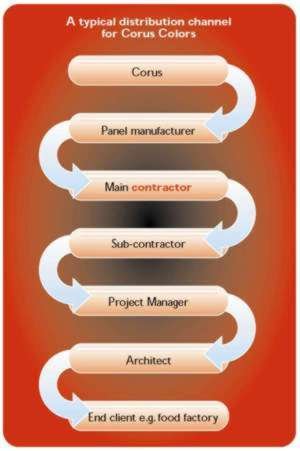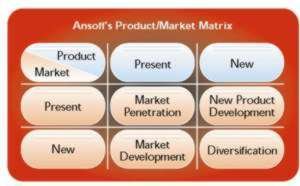Few markets remain in the same state for long. In some cases consumers needs change with some companies choosing to respond. Depending on the nature of the industry, it may or may not be beneficial to be the first to respond. If the innovation is particularly difficult to produce or market, other companies may gain by learning from the mistakes of the innovator. So, being the leader brings risks as well as the prospect of rewards.

This Case Study looks at how Corus has responded to a particular need in its own market and the steps it is taking with a view to achieving success.
Corus was formed through the merger of major steel manufacturers British Steel and the Dutch company Koninklijke Hoogovens in 1999.
Corus provides steel and aluminium solutions for customers worldwide. With a turnover of nearly 12 billion euros in 2003 and almost 50,000 employees worldwide, the Corus brand represents a mark of quality and strength, combining international expertise with local service.
Corus Colors is an international business within the strip products division manufacturing pre-finished steel for the building envelope, consumer products and manufactured goods markets.
A key market for Corus Colors is Controlled Environmental Surfaces (CES). This means supplying material which is able to meet very strict standards in particular contexts. The standard may relate to safety, durability and ease of cleaning. In some environments it is vital to keep surfaces clean and free from any possible source of infection. By eliminating the growth of bacteria, the risk of disease and cross contamination is reduced.
Clearly, this is a vital consideration in hospitals. It is also crucial in other sectors such as food processing, food storage and laboratories. The dangers posed by contaminated work surfaces have made headlines in recent years following several health scares.
Meeting customer needs

In 2000 Corus identified a new opportunity in the CES market. Previously, the company would laminate material and then sell this material to another company, who then manufacture the end product. The end client would request that the material was treated with an anti-bacterial agent.
This two-stage process was time-consuming and expensive. It had a further disadvantage for Corus. The financial gain from the ‘value added process’ came not from making the material but from applying the anti-bacterial agent. So, a company other than Corus was gaining much of the advantage when it came to charging a price that reflected the ‘value added’.
In response to this, Corus developed a laminate that incorporated an antibacterial additive to the process. By differentiating into a niche market Corus were able to adopt a premium pricing policy.
This example of customer led innovation gave Corus the potential to increase its revenues. The new technology was branded Assure(r) which reflects a key aspect of the brand: it helps to provide a safer environment. The launch of Assure in October 2002 was primarily focused on the UK food processing industry.
Soon after the launch, Corus won a contract with Noon Foods, one of the UK’s leading producers of ethnic frozen meals. This was an important breakthrough that Corus was able to announce to the industry at large.
The market
Potential market
The potential market for Assure within the food sector can be divided into two key market segments:
- Industrial sales – This segment includes the walls, ceilings and doors used in cold storerooms at food processing and food manufacturing facilities.
- Retail sales – This segment involves refrigeration units used to keep food cold in retail outlets such as restaurants, butchers and supermarkets.
Distribution

In some industries, the supply chain from the manufacturer to the end user is quite short. In the computer industry, for example, Dell produces computers and sells these direct to customers. In the CES market, however, the supply chain can be much more complicated with many intermediaries.
Suppose a food company is building a new storage facility. It will employ an architect to design the building and appoint a project manager to oversee the construction. The project manager will employ contractors who might also use subcontractors to build the facility. The contractors will need panels produced by a panel manufacturer who in turn will need material to produce the panels.
To be successful, Corus must understand the supply chain and highlight the value of its products to each of them to encourage them to specify Assure. This can be difficult because:
- there are many different intermediaries to deal with
- for each contract there will be a different set of end users, contractors and subcontractors.
A key factor in the process is the needs of the end user, in this case, the food company. Within the food company there are likely to be several people involved in any key decisions. All these people may influence the type of panels used.
Corus must therefore try to understand the needs and objectives of each of these individuals. The hygiene manager, for example, may be most interested in how well Assure kills bacteria, whilst the purchasing manager may focus more on the payment terms.
Promotion
To stimulate sales of Assure, Corus uses both a ‘push’ and ‘pull’ promotion strategy:
- Push – To all the different intermediaries, Corus highlights the benefits of Assure. The aim is to encourage these organisations to recommend that Assure should be used when discussing the project with the end user.
- Pull – Corus tries to stimulate end users’ awareness of Assure so that they build it into the specifications they send out to firms bidding for the construction contract.
To promote Assure, Corus has focused on a range of market communications activities such as public relations, advertising campaigns and direct mails. These activities have concentrated on factually based messages showing the technical benefits of the product, often through the use of case studies. A range of sector specific journals were used to reach the relevant targets and key influencers in the supply chain.
Market growth
Recently the potential market for antibacterial steel within the food sector has been growing. This is the result of:
- changes in consumer tastes that have led to a greater demand for convenience foods e.g. ready-made sandwiches, chilled meals
- tougher legislation on health standards at both national and European level
- greater media focus and public awareness of food safety
- an increasing risk that customers would take legal action if they became ill following infection
- greater focus on risk management, forcing subcontractors to look for ways of demonstrating their commitment to safe methods of production.
Research and development

Research and development involves the use of scientific knowledge to develop new products and processes. An important stage of the research and development process is testing.
New product ideas have to be tested to ensure they are:
- capable of being manufactured
- safe in their intended use
- able to deliver the required performance level
- desired by the market
- able to generate a profit.
If a product is launched without sufficient testing, it can damage the reputation of a business and lead to a loss of sales. In some cases it may also lead to legal action.
Corus pays particular attention to the testing of its products because of its focus on quality. It adopts a Total Quality Management approach that aims to ‘get it right first time’. By insisting on thorough testing at every stage it ensures that a product fulfils its requirements when it is launched.
When working on Assure, for example, Corus tested three different anti-bacterial additives from three different solution providers before making the final choice. Corus wanted to assess:
- the speed with which the different options killed bacteria
- the variety of different bacteria killed.
The additives were tested in the laminate to ensure that they would not adversely affect the desired material properties and the manufacturing process. With a new technology in the offing, the challenge then was to market it.
Ansoff matrix

Ansoff’s Matrix highlights four possible growth strategies for a business.
- Market penetration occurs when a firm tries to sell more of its existing products in its existing markets, perhaps through greater promotional efforts.
- Market development occurs when a firm tries to sell its existing products in a new market e.g. a new segment or country.
- New product development occurs when a firm offers a new product to its existing customers.
- Diversification occurs when a firm develops new products for new markets.
The original product range by Corus Colors focused on Controlled Environment Surfaces (CES). Attempts to boost sales of these products would be an example of a market penetration strategy.
Assure is a new technology being developed for existing customers of Corus in the food market. It is therefore an example of new product development.
Having gained a foothold as a supplier of Assure to the food market, Corus is now looking for opportunities to target new sectors e.g. hospitals. This is an example of market development with an element of diversification too.
The healthcare market is particularly attractive for Assure because:
- hospitals, clinics etc. need help with sustaining sterile environments
- UK governments are committed to increasing healthcare funding, and so hospitals, surgeries, clinics etc have greater spending power.
Another possible market for Assure is the domestic appliances sector, where it can be used on surfaces such as the insides of microwaves, fridges and washing machines.
Conclusion

Assure is still a relatively new technology for Corus. The company is confident of its success because the technology fills an emerging gap in the market and because sufficient demand appears to exist.
In the case of Corus this particular innovation has raised its market profile, has helped to promote its other products and has enhanced its reputation within the industry.
